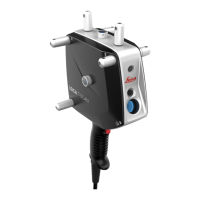Under certain circumstances, the surface of the measuring object (a) can
totally reflect the laser beam. This total reflection occurs when the angle of
reflection is the same as the angle of incidence. In that case, too much light
is returned to the receiver optics. The measuring lens is irradiated and can no
longer correctly detect the position or the measurement distance.
Schematic illustration of a total reflection:
☞
To avoid total reflection during measurement, ensure that the
T‑Scan sensor is optimally orientated toward the measuring
object.
The T‑Scan sensor is able to measure surfaces with varying reflection charac-
teristics; the intensity of the light is regulated automatically.
At a contrast change within a single scan line, the target point of the receiv-
ing optical lens appears to be shifted, due to the varying degree of reflection
of bright and dark surfaces or at object edges. This effect may lead to devia-
tions in the measurement data.
Digitising is the numerical recording of surface coordinates of 3D-lines (char-
acter lines) or freeform surfaces in a variable point grid. The result of digitis-
ing with the T‑Scan is a set of 3D coordinates of the points on the scan lines.
The complete recording of any freeform surface area is called surface digitis-
ing. For digitising an object, any number of single measurements is possible.
Total reflection of
the laser beam
Discontinuous
change of reflec-
tion characteris-
tics
Surface digitising
step-by-step
28 Operation

